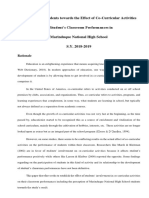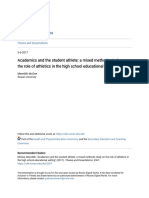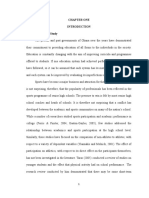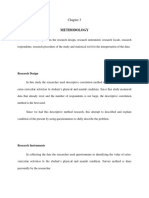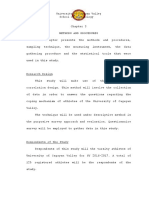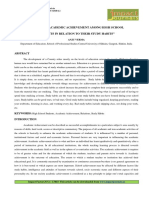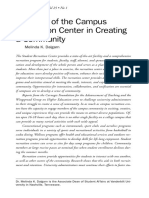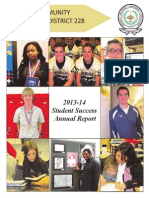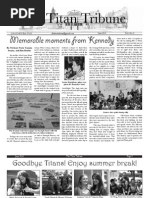Research
Uploaded by
Dee Garcia CarameResearch
Uploaded by
Dee Garcia CaramePage |1
CHAPTER I THE PROBLEM Extracurricular activities play an important role in today's education programs, (Holland & Andre, 1987).
This section provides important information relevant to the study of extracurricular activity and its effect on the academic performance of the College of Hospitality and Tourism Management students. Included in this section is the background of the study, significance of the problem, theoretical framework, conceptual paradigm, statement of
the problem, and necessary definitions. Background of the Study Music, arts, organizational involvement, sports: all of these have an influence on how students perform
academically. The way students choose to spend their time can affect their academic performance. traditional performance. influencing in-class Numerous students instruction studies have that It is not simply impacts the academic factors many
examined
academic
performance
and
extracurricular activities were found to have a significant influence. Numerous studies have been conducted concerning the relationship between extracurricular activities and
academic performance.
Page |2
Extracurricular
activities
are
those
activities
performed by students that fall outside the realm of the normal curriculum of school or university at all education. levels of
Extracurricular
activities
exist
education, elementary, high school, college and university education (www.wikipedia.org). Such activities are generally voluntary as opposed to mandatory and social. Students often organize and direct these activities under faculty such as sponsorship, independent although
student-led are common.
initiatives,
newspapers,
The development of extracurricular activities was slow in the beginning, with many seeing it simply as a fad that would pass and quickly fade out of style (Millard, 1930, p. xi). One of the early philosophies behind extracurricular activities was that they should, wherever at all possible, grow out of curricular activities and return to curricular activities to enrich them (Millard, 1930, p. 12). Eventually, people began to see the benefits of
extracurricular activities, but it took a while to realize it themselves. In fact, before 1900, educators were
skeptical of participation in extracurricular activities, believing defined that school should focus solely on narrowly were
academic
outcomes.
Non-academic
activities
Page |3
often viewed as recreation and therefore were detrimental to academic achievement and consequently, were discouraged (Marsh & Kleitman, 2002, para. 5). Many beneficial performance, related to extracurricular in even building if the activities and have proven to be
strengthening are not
academic obviously have between in
activities
academic studied
subjects. the and
Researchers relationship
particularly extracurricular
activities
academic
performance
college students. At the beginning of the twenty-first century, many
colleges and universities worldwide had a broad educational mission: to develop personal the "whole On student," college thereby campuses,
stimulating
development.
extracurricular involvement is a key tool in this personal development. For the majority of college and university
students, involvement in extracurricular activities plays an integral role in the collegiate experience. Students
become involved in extracurricular activities not only for entertainment, important, to social, gain and and enjoyment improve purposes, A but wide most and
skills.
diversified range of extracurricular activities exists on all college campuses, meeting of a variety of student offers a
interests.
The
University
the
Cordilleras
Page |4
plethora
of
extracurricular
activities
with
the
aim
of
trying to develop the students whole persons. The importance of extracurricular activities on
college campuses is well established. The primary goals of extracurricular activities focus on the individual student level, the institutional level, and the broader community level. These activities academic exist to and complement to augment the the
university's
curriculum
student's educational experience. Extracurricular activities provide a setting to become involved and to interact with other students, thus leading to increased learning and enhanced development.
Specifically, a student's peer group is the most important source of influence on a student's academic and personal development. By identifying with a peer group, that group may influence a student's affective and cognitive
development as well as his or her behavior. As the development of the individual is the main goal of extracurricular activities on college and university have
campuses, the numerous experiences these activities
impacts on students' emotional, intellectual, social, and interpersonal development. Students also develop skills
specific to their career path and imperative for future job success. Students have opportunities to improve their
Page |5
leadership and interpersonal skills while also increasing their self-confidence. Because range of of the diverse interests activity of students, the
extracurricular
offerings
varies
extensively, depending upon the size and type of college or university. Extracurricular activities range from primarily social organizations to governance programs. Each organizations activity to
intercollegiate
athletic
offers
students an opportunity to work with others and to gain essential life skills. Though numerous extracurricular activities exist, the following activities are those that are most commonly found on college campuses: a. Student Government One of the most widespread available types on of
extracurricular
experience
college
campuses is student government. Students involved in governance their organizations to of are typically as to the the elected by
peers
function students
official university
representatives
administration. These government participants often serve on campus-wide committees in an effort to
represent the ideas and concerns of their fellow students. Student government functions include
Page |6
allocating programs
funds
to to
other
organizations, interests,
planning providing
related
student
forums for student issue discussion, and helping to build and sustain a successful of campus community. governance
Additional
examples
campus
organizations include honor councils, which seek to enforce a university's honor code, and judiciary
boards, where students hear disciplinary cases and render verdicts. A typical example of this would be the University of the Cordilleras Supreme Student Governance or university-known as Pamunuan and
Kalipunan. b. Athletic Activities All college and universities offers some type of intercollegiate and intramural athletics. Student
athletes may "try out" for intercollegiate sports teams such as volleyball, basketball, etc. Being a varsity athlete requires a great commitment of time and energy for practicing, conditioning, and
competing. Intramural sports provide opportunities for all student athletes to play a sport they enjoy, while competing against their peers. Typically,
colleges and universities offer several intramural options which typically include basketball, table
Page |7
tennis, badminton, chess, and volleyball. Students are invited to participate and often, these
activities may be quite competitive. c. Academic and Professional Organizations Academic assist their major and professional in acquiring field and organizations experience sometimes in in
their chosen
members
occupational
aiding in the job search. Students gather to discuss issues related to
their field of interest and to learn job-related skills in an effort to be fully prepared for future success. Such professional organizations typically focus on one career area of interest. Examples of professional organizations of the College of
Hospitality and Tourism Management of the University of the Cordilleras include the Front Liners, Voices, Movers, Young Chefs, UCians Flairtending
Organization, Newsletter and Debate Team which all fall under the colleges official club organization, the Toureshma Executive Club. d. Volunteer and Service-Related Activities Volunteer and service-related activities exist to help improve the local community, an important goal of extracurricular activities. In the UC Project
Page |8
H.E.L.E.N, volunteer students from various colleges engage in community service projects such as
planting trees or donating unused clothes or books which promote service and volunteerism during the college students community. e. Multicultural Activities Multicultural activities focus on increasing years. an Service-learning to programs to offer their
opportunity
contribute
awareness and understanding of various cultures and ethnic and racial backgrounds. Many schools sponsor festivals, concerts, lectures, and discussions that promote multicultural awareness on campus in which students may participate. In addition, involvement in these activities may be an important step toward positive racial, ethnic, or sexual-identity
development. An example of this activity would be the recently re-established BIMAK (Benguet, Ifugao, Mountain Province, Abra and Kalinga) Brotherhood
where students who came from these five provinces and who belong to different colleges can join the brotherhood.
Page |9
f. Arts Students interested in arts have a plethora of extracurricular actively musicals, students Marching groups opportunities in which they can
participate. and to dance
Activities concerts their
including a
plays, for
offer
chance
demonstrate jazz
dramatic
abilities. singing musical
band, allow
band, to
orchestra, pursue
and
students
their
interests at the college level. Pottery, sculpture, and mosaic classes and workshops are also offered for students to learn and enjoy. g. Other Activities In addition to the specific extracurricular other activities Honorary
activities exist on
previously many
mentioned,
college
campuses.
organizations recognize student scholars, often in a certain academic discipline, who maintain a specific grade point average. Religious organizations offer students an opportunity to gather in fellowship with students of similar on religious campus backgrounds. of Media print,
organizations
consist
television, and radio venues, and these activities may include writing or taking pictures for the
school newspaper, serving on the yearbook staff, or
P a g e | 10
working
as
disc
jockey
for
the
campus
radio
station. Individuals interested in politics may join the UC Debate Team. It is obvious that extracurricular activities have an impact on academic performance and education. Due to the dynamic nature of the Hospitality an
Tourism industry, the College of Hospitality and Tourism Management students of the University of the Cordilleras need to participate in the various extracurricular
activities to showcase their skills and talents as well as to immerse themselves the to the real-life situations It is that
happen
outside
school
environment.
through
extracurricular activities that these students learn and acquire career. Having said that, the question really is, how are new sets of skills that they can use in their
extracurricular
activities
affecting
the
academic
performance of Hospitality and Tourism Management students of the University of the Cordilleras today? Significance of the Study The results of this study will add to the body of information regarding the value of extracurricular
activities for Hospitality and Tourism Management students. It will provide educators, most especially the University
P a g e | 11
of
the
Cordillera
and
its
College
of
Hospitality
and
Tourism Management as well as the public, with information to assist students in making more informed choices in their extracurricular school programs. This study will also be a benefit to other researchers who will be conducting future studies of similar subject matter in that this study will offer multiple perspectives regarding the effects of extracurricular activities on the academic performance of the said colleges students. The proposed study will benefit and help the future researchers as their reference or guide. It will also help students to identify and decide
which extracurricular activity will suit them most. The research proposal will contribute to knowledge
production in general. The purpose of this is to gain a better understanding of perspective on the effects of
extracurricular activities on the academic performance of the University of the Cordilleras College of Hospitality and Tourism students. It will contribute to a deeper
comprehension of the effects of extracurricular activities on the academic performance of the students. Theoretical Framework of the Study It has been generally assumed that participation in extracurricular activities has a positive impact on the
P a g e | 12
academics these
of
students. may
However, actually
many affect
also
believe
that
activities
student
academic
performance in a negative manner due to conflicting time requirements and competing schedules, even if they do in fact enhance student persistence. Interestingly, relatively few studies have been performed in either of these areas due to a lack of applicable data. The importance of personal responsibility and activity for academic achievement learning stems from the perspective academic of and
self-regulated
through
extracurricular activities. According to this perspective, the student is responsible because he or she perceives him or herself as a learner (Zimmerman, 1989). The student can use different to learning create strategies and that engage are in various to
activities learning values
environments 1989).
conducive
(Zimmerman, of
Hence,
because are
reinforcing different,
extracurricular
activities
students choose different activities that they think suit them best. There devoted to has been a considerable the amount of research student
studying
relationship
between
involvement in activities and student academic performance. Although a positive correlation has been shown in many of these studies, there is still a fierce battle among
P a g e | 13
educators
concerning
the
benefits
and
impacts
of
extracurricular activities. Two positions appear to be prevalent in today's
academic community. These are referred to as either the academic or developmental perspective. The academic
perspective considers extracurricular activities as purely leisure and not part of the purpose considers total of schools. The
developmental activities
perspective to the
extracurricular of the
necessary
development
student in today's schools (Holland & Andre, 1987). Educators who believe in the academic perspective
argue that time spent away from the classroom decreases the student's chances for success. Even those activities that don't require loss of classroom time are perceived to take away study time. These educators support cutting or
eliminating activities for budgetary reasons. Educators who believe in the developmental perspective see activities as an extension of the educational program. Activities leadership, confidence, allow students to develop skills such as
sportsmanship, and the ability
self-discipline, to handle
self-
competitive
situations. Extracurricular activities offer an opportunity to interact in ways that allow the previously mentioned skills to blossom. The developmental minded believe that
P a g e | 14
many of these skills would be impossible or very difficult to develop in a classroom setting. Marsh (1992) stated: According to different theoretical perspectives, extracurricular activity participation may be posited to (a) divert attention from academic pursuits, as
evidenced by its negative effects on narrowly defined academic goals; (b) have little or no effect on academic outcomes but contribute to desirable nonacademic outcomes; or (c) have positive effects on nonacademic outcomes and facilitate academic growth, perhaps indirectly, as
well. (p. 553). Different both inside activities outside in the which students itself, participate, are among
and
school
multiple situations or agents that can have an effect on academic performance. This situation has given rise in todays universities to an almost massive involvement in extracurricular
activities, complementing and strengthening not only the students school performance, but also his or her personal development values, etc. and other aspects such as leisure, health,
P a g e | 15
The
world
is of
currently activities,
witnessing be they
an
increasing or
proliferation
academic
extracurricular. Instructors on occasion complain that some students are over-involved in extracurricular activities
and that these are sometimes pre-determined by parents or are not well-planned, thus failing to coordinate with or complement with academic performances. Along these lines, Marsh and Kleitman selected those (2002), and that state at place that the extracurricular school are since more the
activities helpful
planned take
than
outside,
latter often lack sufficient planning, order, and logical meaning. Some researchers have divided extracurricular
activities into informal and formal activities. The formal activities include activities which are relatively
structured, such as participating in athletics or learning to play a musical instrument. Informal activities, on the other hand, also known as leisure activities, include less structured activities, such as watching television. Some literature on leisure studies has suggested that formal and informal activity settings have different influences on motivation and feelings of competence, two factors which influence academic performance (Guest & Schneider, 2003, para. 8). One study found that more time in leisure
P a g e | 16
activities was related to poorer academic grades, poorer work habits, and poorer emotional adjustments, while more time in structured groups and less time watching TV were associated with higher test scores and school grades
(Marsh & Kleitman, 2002, para. 15). Guest and Schneider (2003), in their study, found that the type of participation or activity undertaken
influences developmental outcomes (Para. 8). This involves the what factor and is the many concern studies of this research on the
project.
There
have
been
conducted
influence that extracurricular activities have on academic performance. Their effects have differed substantially for different activities. There were a total of seventy-six
statistically significant effects, fifty-eight positive and eighteen negative (Marsh & Kleitman, 2002, para. 11). It is reported that the average college student spends only 30 percent 1990). of A his or her body waking of hours in class exists
(Collison,
large
research
supporting the argument that a students time outside of the classroom should be spent engaged in an extracurricular activity. Researchers agree that student involvement can enhance the overall college experience. In Astin his (1984) Developmental states that Theory the for Higher the Education, students
greater
P a g e | 17
involvement in college, the greater will be the amount of student learning and personal development (p. 529). Astin also argues that educational impact will be greater if the student is able to connect with his or her institution (Astin, 1984). Clubs, activities organizations allow students and to other extracurricular this connection
establish
through interaction with peers and members of the faculty (dAmico & Hawes, 2000). Although research has shown that student involvement positively impacts the overall development of a student, a debate exists have regarding on the effects extracurricular Some people
activities
academic
performance.
believe that the time required to actively participate in extracurricular activities can interfere with academic
studies which will result in lower grades (Huang & Chang, 2004; Mehus, 1932). Definition of Terms The following terms are applicable to the study: Extracurricular activity Any non-graded activity that requires students to extend their school day. These activities take place either before school, after school, weekends, or
during holiday vacations.
P a g e | 18
Academic performance A measurement set out of by how well a student and meets the
standards
local
government
institution itself. Academic achievement Excellence in all academic disciplines, in class as well as extracurricular in sporting, skills, activities. behavior, It includes
excellence communication
confidence, assertiveness,
punctuality,
Arts, culture, and the like. Participation The investment of physical and psychological
energy in the collegiate environment.
P a g e | 19
CONCEPTUAL PARADIGM OF THE STUDY INPUT
Extracurricular Activities of Tourism and Hospitality students of the University of the Cordilleras Student Government Athletic Activities Academic and Professional Organizations Volunteer and Service-Related Activities Multicultural Activities Other Activities
PROCESS
Collection of data through Questionnaire
FEEDBACK
OUTPUT Academic Performance of the students of Hospitality and Tourism Management students A. Positive B. Negative
P a g e | 20
Statement of the Problem The research aims to study the extracurricular
activities and its effect on the academic performance of Hotel and Restaurant Management students of the University of the Cordilleras. Specifically, questions: 1. Is there a significant activities relationship and students between academic it sought to answer the following
extracurricular performance? 2. Are
extracurricular
activities
done
by
students
significant predictor of their academic performance? 3. Are there any effects of extracurricular activities on the students academic performance? 4. What are the extracurricular activities that students are involved in? 5. Is there a significant difference on the effects of extracurricular activities on academic performance in terms of: a. Age b. Gender c. Year Level
P a g e | 21
6. What are the positive and negative effects of having extracurricular activities on the students academic performance? 7. What are the common problems encountered by
Hospitality and Tourism Management students caused by being involved in extracurricular activities? Statement of the Hypotheses In this section, efforts will be made to answer the extracurricular activities involvement of the Hospitality and Tourism Management students of the University of the Cordilleras, and how such activities could affect their
academic performance. It will be the primary purpose of this study to therefore investigate the significant effect of extracurricular activities on the academic performance of Hospitality and Tourism this Management five students. hypotheses To were
effectively
anchor
purpose,
formulated. They are: 1. There will be no significant and relationship students between academic
extracurricular performance. 2. Extracurricular
activities
activities
are
not
significant
predictor of students academic performance. 3. There will be no relative effect of extracurricular activities on the academic performance of students.
P a g e | 22
4. There effects
will of
be
no
significant
difference on
on
the
extracurricular
activities
academic
performance in terms of: a. Age b. Gender c. Year Level 5. There are no common problems encountered by students who do extracurricular activities.
P a g e | 23
CHAPTER II RESEARCH DESIGN AND METHODOLOGY This chapter of the study aims to explain the methods and procedures to be used in conducting the study. Included herein locale are of the the the method study, sampling of research, the population instruments the and and
the
research and
techniques, treatment.
procedure
statistical
Research Design The research design that will be used for this study would be the descriptive method. Descriptive research, population research, data also and known as statistical about the
describes or
characteristics studied.
phenomenon
being
Descriptive
research answers the questions who, what, where, when and how. It systematically, factually, accurately and
objectively describes a problem or a phenomenon and it aims to describe the nature of a situation as it exists at the time of the study and to explore the cause of a particular situation. Population and Locale of the Study The study at will the be College conducted of in Baguio and City, Tourism
particularly
Hospitality
P a g e | 24
Management
at
the
University
of
the
Cordilleras
Legarda
Annex. The study will focus on the Hospitality and Tourism Management students of all year levels. Sampling Technique The researchers will be applying simple random
sampling procedure in selecting its sample population. Simple random sampling is the basic sampling technique where researchers select a group of subjects (or a sample) for study from a larger group (a population). Each
individual is chosen entirely by chance and each member of the population has an equal chance of being included in the sample. Every possible sample of a given size has the same chance of selection. Making use of this sampling technique, it will make sure that every student belonging to the College of
Hospitality and Tourism Management of the University of the Cordilleras will have an equal chance of being the
respondent for the study. In this manner, determining the sample population for the study is easier as the sample size is entirely chosen by chance. Students who are having their break time at the time that questionnaires will be distributed are likely to be the sample population of this study.
P a g e | 25
Data Gathering Tools The researchers will be using questionnaire as their major data gathering instrument. All questions will be
pertinently formulated based on the problems that need to be answered. All questions would be directly related to the problem which is the Extracurricular activities and its effect Tourism on the academic performance of the of Hospitality of and the
Management The
students
University of
Cordilleras.
questionnaire
consists
several
questions with checklist options relevant to the topic of the research. The questionnaire will be distributed to the respondents at the locale of the study. Also, brief
interviews will be conducted as well to gather supporting data. Data Gathering Procedure The questionnaires will be floated to the respondents (students of all year level) during lunch time and break time or vacant time at the University of the Cordilleras Legarda Annex, particularly at the student lounge as well as the library. All questionnaires will be thoroughly
inspected upon its return to the researchers to make sure that all questions were answered.
P a g e | 26
Statistical Treatment of Data Since the research design of the study would be a descriptive method, it will use the frequency percentage method. The frequency will be taken by gathering the number of the respondents and divided by the total number of
respondents multiplied by 100% then ranked from highest to lowest. The Formula will be: P= f/N x 100% Where: P= percentage F= Frequency N= total number of respondents 100%= constant multiplier
P a g e | 27
REFERENCES Bauer, K.W.& Liang, Q. (2003). The effect of personality and precollege characteristics on first-year activities and academic performance. Journal of College Student Development, 44, 277-290. Moriana, J.A., Alos, F., Alcala, R., Pino, M.J., Herruzo, J., & Ruiz, R. (2006). Extra-curricular activities and academic performance in secondary students. Electronic Journal of Research in Educational Psychology, pp. 35-46. Wang, J. & Shiveley, J. (2009). The impact of extracurricular activity on student academic performance, pp. 3-15. ODea, James W (1994). The effect of extracurricular activities on academic achievement, pp. 5-25. Harvancik, M. J. (1 986).Academic success and participation in high school Washington, DC: Annual Convention of the American Psychological Association (ERIC Document Reproduction Service No. ED 273887) Camp, W. G. (1990). Participation in student activities and achievement: A covariance structural analysis. Journal of Educational Research, &3(5), 272-278. Mello, Z. & Worrell, F. (2008). Gender variation in extracurricular activity participation and perceived life chances in Trinidad and Tobago adolescents, pp. 9-13.
P a g e | 28
Fujita, K. (2010). The effects of extracurricular activities on the academic performance of junior high students, pp. 5-15. Broh, B. A. (2002, January). Linking extracurricular programming to academic achievement: Who benefits and why? [Electronic version]. Sociology of Education, 75, 69-96. n.d. Retrieved at http://www.ehow.com/info_8034677_effectextracurricular-activities-academicgrades.html#ixzz1WU6N2Erw on August 27, 2011 at 5:15 PM. n.d. Retrieved at Negative Aspects of Extracurricular Activities | eHow.com http://www.ehow.com/info_8142748_negative-aspectsextracurricular-activities.html#ixzz1WU8zcFPc on August 27, 2011 at 5:20 PM. n.d. Retrieved at http://en.wikipedia.org/wiki/Extracurricular_activity on August 28, 2011 at 8:00 AM.
You might also like
- The Role of Extra and Co - Curricular ActivitiesNo ratings yetThe Role of Extra and Co - Curricular Activities31 pages
- The Effects of Extra Curricular Activities To The Academic Performance of The Students100% (1)The Effects of Extra Curricular Activities To The Academic Performance of The Students44 pages
- Leadership Involvement As An Extracurricular Activity and Its Effect On The Learning Performance of Student LeadersNo ratings yetLeadership Involvement As An Extracurricular Activity and Its Effect On The Learning Performance of Student Leaders23 pages
- School Organization and Academic PerformNo ratings yetSchool Organization and Academic Perform31 pages
- The Relationship Between Extracurricular Activities and The Academic Performance of Grade 12 GAS Students in ACLC 1No ratings yetThe Relationship Between Extracurricular Activities and The Academic Performance of Grade 12 GAS Students in ACLC 18 pages
- Effects of Extracurricular Activities inNo ratings yetEffects of Extracurricular Activities in28 pages
- The Relationship Between Extracurricular Activities and AcademicNo ratings yetThe Relationship Between Extracurricular Activities and Academic16 pages
- Liceo de Cagayan University Senior High School DepartmentNo ratings yetLiceo de Cagayan University Senior High School Department32 pages
- A Study Between Sports Participation andNo ratings yetA Study Between Sports Participation and23 pages
- The Effects of Sports Participation On Academic Performance Among Grade 10 Students of Dasmariñas Integrated HighschoolNo ratings yetThe Effects of Sports Participation On Academic Performance Among Grade 10 Students of Dasmariñas Integrated Highschool3 pages
- Academics and The Student Athlete - A Mixed Methods Study On The RNo ratings yetAcademics and The Student Athlete - A Mixed Methods Study On The R188 pages
- A Study of The Impact of Extracurricular Activities On Social Development of Students Studying in VIII Class of SchoolNo ratings yetA Study of The Impact of Extracurricular Activities On Social Development of Students Studying in VIII Class of School45 pages
- Effects of Extracurricular Activities On StudentsNo ratings yetEffects of Extracurricular Activities On Students19 pages
- Exploring How Student Athletes Balance Athletic Academic and Personal Needs. PDFNo ratings yetExploring How Student Athletes Balance Athletic Academic and Personal Needs. PDF35 pages
- The Effects of Participation in Extracurricular Activities On TheNo ratings yetThe Effects of Participation in Extracurricular Activities On The75 pages
- The Impacts of Extracurricular Activities On The Academic Performance of Grade 11 Students in SNHSNo ratings yetThe Impacts of Extracurricular Activities On The Academic Performance of Grade 11 Students in SNHS7 pages
- Sports and Their Impact On Academic Performance in School StudentsNo ratings yetSports and Their Impact On Academic Performance in School Students2 pages
- Effects of Sports Participation On The Academic Performance of Senior High School Students in MathematicsNo ratings yetEffects of Sports Participation On The Academic Performance of Senior High School Students in Mathematics13 pages
- Assessing The Level of Engagement in Extracurricular Activities To The Academic Performance of The StudentsNo ratings yetAssessing The Level of Engagement in Extracurricular Activities To The Academic Performance of The Students70 pages
- (PDF) Impact of Extracurricular Activities On Academic Performance of Students at Secondary LevelNo ratings yet(PDF) Impact of Extracurricular Activities On Academic Performance of Students at Secondary Level1 page
- Effects of Extra-Curricular Activities On The Academic Performance of BCAS Junior High School This S.Y 2017-2018No ratings yetEffects of Extra-Curricular Activities On The Academic Performance of BCAS Junior High School This S.Y 2017-201851 pages
- Academic Validation, Motivation, and Anxiety Among College Students in Lipa City CollegesNo ratings yetAcademic Validation, Motivation, and Anxiety Among College Students in Lipa City Colleges26 pages
- Grade 12 Student-Athletes' View of Athletic Involvement On Perceived Academic EfficiencyNo ratings yetGrade 12 Student-Athletes' View of Athletic Involvement On Perceived Academic Efficiency16 pages
- You Consumed My Time - The Effects of Co-Curricular Activities To The Academic Performance of Grade 10 Students in SMMS A.Y. 2019 - 2020 (1st Title)No ratings yetYou Consumed My Time - The Effects of Co-Curricular Activities To The Academic Performance of Grade 10 Students in SMMS A.Y. 2019 - 2020 (1st Title)18 pages
- The Impact of Extracurricular Activities OnNo ratings yetThe Impact of Extracurricular Activities On4 pages
- Effects of Student's Extracurricular Activities To School's Internal Efficiency: Basis For School Improvement Management Plan100% (1)Effects of Student's Extracurricular Activities To School's Internal Efficiency: Basis For School Improvement Management Plan12 pages
- Impact of Extracurricular Activities On Academic Performance of Students0% (1)Impact of Extracurricular Activities On Academic Performance of Students15 pages
- Practical Research 1 Management of Stress and Anxiety in School and Home Day-To-Day Basis of Collegiate and High School Students100% (1)Practical Research 1 Management of Stress and Anxiety in School and Home Day-To-Day Basis of Collegiate and High School Students15 pages
- Influence of Social Pressures On The Academic Performance of HUMSS Students at NU-NazarethNo ratings yetInfluence of Social Pressures On The Academic Performance of HUMSS Students at NU-Nazareth31 pages
- Effects of Training To The ABM Student Athletes0% (1)Effects of Training To The ABM Student Athletes18 pages
- A Study of Academic Achievement Among High School Students in Relation To Their Study Habits100% (4)A Study of Academic Achievement Among High School Students in Relation To Their Study Habits14 pages
- Dalgarn 2001 The Role of The Campus Recreation Center in Creating A CommunityNo ratings yetDalgarn 2001 The Role of The Campus Recreation Center in Creating A Community7 pages
- Mayor's Youth Zone Newsletter February 2013No ratings yetMayor's Youth Zone Newsletter February 201316 pages
- The Annual Quality Assurance Report (AQAR) of The IQACNo ratings yetThe Annual Quality Assurance Report (AQAR) of The IQAC9 pages
- Student Edge Curtin University Case StudyNo ratings yetStudent Edge Curtin University Case Study10 pages
- ST Catherine University Campus Map August 2022No ratings yetST Catherine University Campus Map August 20221 page
- Assam Current Affairs - July 2023 - Gradient IAS - CompressedNo ratings yetAssam Current Affairs - July 2023 - Gradient IAS - Compressed14 pages
- Educational Qualifications: PH.D: Bpe., Mpe: NET., UGC 1999 and 2003No ratings yetEducational Qualifications: PH.D: Bpe., Mpe: NET., UGC 1999 and 20033 pages
- The Effects of Extra Curricular Activities To The Academic Performance of The StudentsThe Effects of Extra Curricular Activities To The Academic Performance of The Students
- Leadership Involvement As An Extracurricular Activity and Its Effect On The Learning Performance of Student LeadersLeadership Involvement As An Extracurricular Activity and Its Effect On The Learning Performance of Student Leaders
- The Relationship Between Extracurricular Activities and The Academic Performance of Grade 12 GAS Students in ACLC 1The Relationship Between Extracurricular Activities and The Academic Performance of Grade 12 GAS Students in ACLC 1
- The Relationship Between Extracurricular Activities and AcademicThe Relationship Between Extracurricular Activities and Academic
- Liceo de Cagayan University Senior High School DepartmentLiceo de Cagayan University Senior High School Department
- The Effects of Sports Participation On Academic Performance Among Grade 10 Students of Dasmariñas Integrated HighschoolThe Effects of Sports Participation On Academic Performance Among Grade 10 Students of Dasmariñas Integrated Highschool
- Academics and The Student Athlete - A Mixed Methods Study On The RAcademics and The Student Athlete - A Mixed Methods Study On The R
- A Study of The Impact of Extracurricular Activities On Social Development of Students Studying in VIII Class of SchoolA Study of The Impact of Extracurricular Activities On Social Development of Students Studying in VIII Class of School
- Exploring How Student Athletes Balance Athletic Academic and Personal Needs. PDFExploring How Student Athletes Balance Athletic Academic and Personal Needs. PDF
- The Effects of Participation in Extracurricular Activities On TheThe Effects of Participation in Extracurricular Activities On The
- The Impacts of Extracurricular Activities On The Academic Performance of Grade 11 Students in SNHSThe Impacts of Extracurricular Activities On The Academic Performance of Grade 11 Students in SNHS
- Sports and Their Impact On Academic Performance in School StudentsSports and Their Impact On Academic Performance in School Students
- Effects of Sports Participation On The Academic Performance of Senior High School Students in MathematicsEffects of Sports Participation On The Academic Performance of Senior High School Students in Mathematics
- Assessing The Level of Engagement in Extracurricular Activities To The Academic Performance of The StudentsAssessing The Level of Engagement in Extracurricular Activities To The Academic Performance of The Students
- (PDF) Impact of Extracurricular Activities On Academic Performance of Students at Secondary Level(PDF) Impact of Extracurricular Activities On Academic Performance of Students at Secondary Level
- Effects of Extra-Curricular Activities On The Academic Performance of BCAS Junior High School This S.Y 2017-2018Effects of Extra-Curricular Activities On The Academic Performance of BCAS Junior High School This S.Y 2017-2018
- Academic Validation, Motivation, and Anxiety Among College Students in Lipa City CollegesAcademic Validation, Motivation, and Anxiety Among College Students in Lipa City Colleges
- Grade 12 Student-Athletes' View of Athletic Involvement On Perceived Academic EfficiencyGrade 12 Student-Athletes' View of Athletic Involvement On Perceived Academic Efficiency
- You Consumed My Time - The Effects of Co-Curricular Activities To The Academic Performance of Grade 10 Students in SMMS A.Y. 2019 - 2020 (1st Title)You Consumed My Time - The Effects of Co-Curricular Activities To The Academic Performance of Grade 10 Students in SMMS A.Y. 2019 - 2020 (1st Title)
- Effects of Student's Extracurricular Activities To School's Internal Efficiency: Basis For School Improvement Management PlanEffects of Student's Extracurricular Activities To School's Internal Efficiency: Basis For School Improvement Management Plan
- Impact of Extracurricular Activities On Academic Performance of StudentsImpact of Extracurricular Activities On Academic Performance of Students
- Practical Research 1 Management of Stress and Anxiety in School and Home Day-To-Day Basis of Collegiate and High School StudentsPractical Research 1 Management of Stress and Anxiety in School and Home Day-To-Day Basis of Collegiate and High School Students
- Influence of Social Pressures On The Academic Performance of HUMSS Students at NU-NazarethInfluence of Social Pressures On The Academic Performance of HUMSS Students at NU-Nazareth
- A Study of Academic Achievement Among High School Students in Relation To Their Study HabitsA Study of Academic Achievement Among High School Students in Relation To Their Study Habits
- Dalgarn 2001 The Role of The Campus Recreation Center in Creating A CommunityDalgarn 2001 The Role of The Campus Recreation Center in Creating A Community
- The Annual Quality Assurance Report (AQAR) of The IQACThe Annual Quality Assurance Report (AQAR) of The IQAC
- Assam Current Affairs - July 2023 - Gradient IAS - CompressedAssam Current Affairs - July 2023 - Gradient IAS - Compressed
- Educational Qualifications: PH.D: Bpe., Mpe: NET., UGC 1999 and 2003Educational Qualifications: PH.D: Bpe., Mpe: NET., UGC 1999 and 2003










